Dataviz: A Critical Skill for Modern Marketers
- Fahad H

- Apr 4, 2018
- 8 min read
A decade ago a friend bought me a copy of Edward Tufte’s iconic book Beautiful Evidence.
The professor emeritus of political science, statistics, and computer science at Yale University has spent his career teaching others how to turn information and data into elegantly crafted drawings and graphics – and even more, doing so in a way that illuminates in interesting and unexpected ways.
Inspired by him, I set out to learn more about visualizing data, and how to use it in everyday life. The subject area is massive and at times overwhelming, but data visualization (sometimes called “dataviz”) is among the most critical skills for marketers to understand at least at the basic level, if not to study in more depth. Let’s walk through the what, how, and why of data visualization for marketing.
HANDPICKED RELATED CONTENT: Building Your Content Marketing Team? 14 Skills for New, Growing, and Mature Programs
What’s data visualization?
Put simply, dataviz is the art and science of displaying information (data) in visual form. While bar charts are a form of dataviz, the term is more often used to describe the translation of complex or nuanced data into summarizing, artful images. One of the most highly rated sessions at Content Marketing World was from Scott Berinato, senior editor at the Harvard Business Review and author of Good Charts: The HBR Guide to Making Smarter, More Persuasive Data Visualizations. In an interview with CCO magazine, Scott explains that in today’s data-abundant world, finding ways to extract human insights from data is a key challenge (and critical skill):Finding ways to extract human insights from data is a critical skill, says @scottberinato. #dataviz Click To Tweet
“The amount of information coming at us is insane. It’s overwhelming. So visualization serves two purposes. First, it serves a prosaic purpose. It gets people’s attention … When you’re fighting for attention, whether in a Twitter feed or even in a presentation, visuals work …
“Second, it solves the problem of relaying complex information. Consider something as simple as trying to understand the gun debate in America. There are so many people saying so many things about guns. Visualization is a way of making sense of all the data, ideas, and information.”
What’s the application for marketers?
Let’s explore two practical and easy-to-understand ways marketers use dataviz as well as real-world cases showing how it’s applied.
Dataviz as marketing insight
The scenario Scott explains – living at a time of data abundance – is particularly true for marketers. Whether we are reviewing our analytics platforms, mining user data for insights, or reviewing sales performance to understand what variables are driving (or dampening) growth, visualizing this information is critical to make sense of what can be overwhelming detail.
Among the most interesting examples I’ve read of late is a case study published by Tableau (the data visualization software company) about its work with outdoor retailer REI. (You can read the full case here.) Managers across REI visualize owned data – online and in-store transactions, operations information, buyer demographics, etc. – to extract insights and improve customer experience.
What used to be done inelegantly with Excel is now visualized instantly using Tableau dashboards. And because Tableau lets you interrogate the data and visualize findings – sorting, slicing, and filtering in real time – it is more likely to surface interesting and unexpected findings. (No more static decks with a single view chosen by the presenter.)
HANDPICKED RELATED CONTENT: Data-Driven Content Strategy Meets Content Marketing [Essential Template]
Dataviz as content
Maybe you’re curious about using marketing data, but deep marketing analytics is a step beyond what you’re interested in? The use case nearest to my heart is publishing data as content marketing. Research can take many forms. Some companies host surveys to gather insights about their industries (salary guides and “state of” reports come to mind). Others analyze third-party data (such as public datasets or licensed data) to uncover new ideas or create interesting infographics. And still others find that their internal data can generate interesting lessons to share.
My favorite examples take their original research and make it sing using strong data visualizations to present findings. Among my recent favorites:Take original research and make it sing using strong #data visualizations to present findings, says @clare_mcd. Click To Tweet
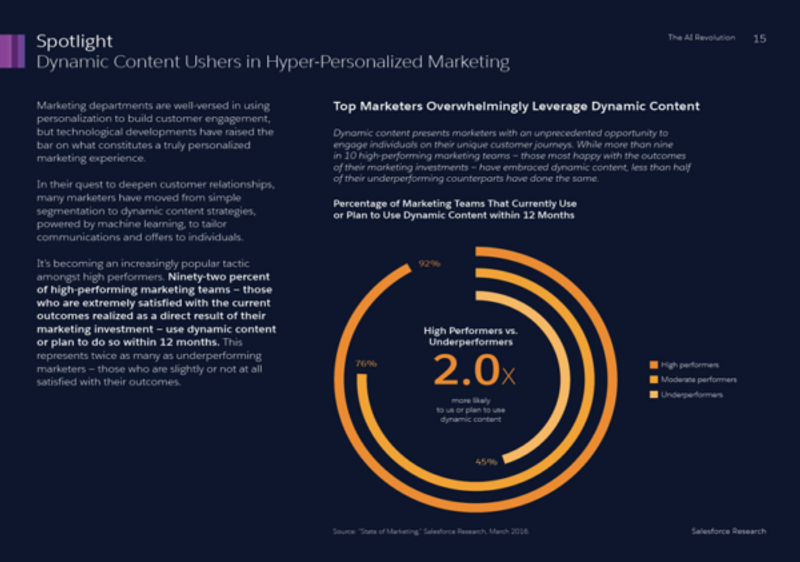
Salesforce does a nice job with its research efforts in large part because of the strict information design that underlies each publication. Charts and graphs are clean and easy to understand. Rather than simply restating research findings, Salesforce explains its point of view on key issues affecting the industry. Salesforce’s AI Revolution report is a great example of its design ethic.
Not every viz needs to be a serious exercise in thought leadership. The avocado toast index is a great example of using existing data in a new and hilarious way.
Not every viz of #data needs to be a serious exercise. @BBC avocado toast index is great example. @clare_mcd Click To Tweet
Most helpful tips for dataviz
Let’s be frank. Learning how to visualize data is a massive subject that you could spend years refining and finessing. Rather than trying to sum up a complex discipline, I’ll give the basics that will be most helpful:
Clarity not cleverness
This is the biggest lesson of all. Great data visualization isn’t fussy or ornate. With so many tools that make it easy for marketers to visualize data, there’s a tendency to let “cool” win out over the simple stuff. Don’t fall for it. Simplicity is much more credible and appreciated than overly ornate (and opaque) visualizations.Great data visualization isn’t fussy or ornate, says @clare_mcd. #dataviz Read more>> Click To Tweet
Ask “so what?”
One newbie mistake is the desire to publish every finding from a survey though your reader doesn’t have the interest or attention for it. For each dataviz, you should be able to answer the question, “So what?” Why does this point matter? How does it add to my story? (Plus, loading your report with dozens of data graphics is expensive.)
Guide the eye
Sometimes your readers need a gentle nudge. Where should they be looking? What data point in your chart is most important? Consider adding guides to your dataviz to point out which finding is interesting or what gap is most surprising. These little hints – if used sparingly – are helpful to those encountering your viz for the first time.
HANDPICKED RELATED CONTENT: 5 Important Visual Lessons From Designers for Content Marketers
Use color wisely
Color should not be decorative; it should be clarifying. Unless you are using colors to distinguish categories, do not use more than one color (or a single-color palette). For example, if you’re presenting a bar chart where one data point (i.e., bar) is most interesting, make that bar your primary color and gray the other bars so they recede to the background. These visual cues help your viewer focus on what matters.
The chart from Udemy uses multiple colors, but it uses them to distinguish among generations – a good use case.
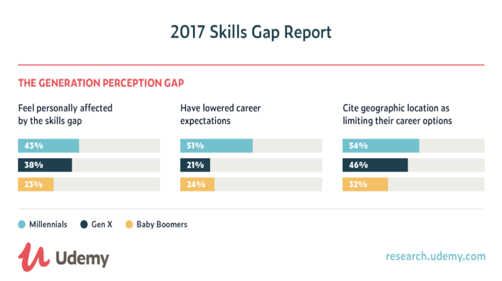
The chart from The Wall Street Journal highlights huge box office sales for Black Panther by showing that film in red, and using a light blue for all other data points. Doing this ensures that the reader knows where to look on a relatively “busy” visual.
‘Black Panther’ has become one of the most successful movies ever in a near-record amount of time, completely dominating the winter box office in the process https://t.co/l4MQtMOgSu pic.twitter.com/aCu1I2xyZx — WSJ Graphics (@WSJGraphics) April 1, 2018
Choose chart types carefully
The pie chart is a popular choice to visualize percentages that add up to 100%, but it’s often not the optimal choice. Beyond a few slices, it’s hard to compare the relative size of each section. Bar charts are the workhorses of dataviz for good reason (for a longer list of variables, horizontal bar charts often work better).
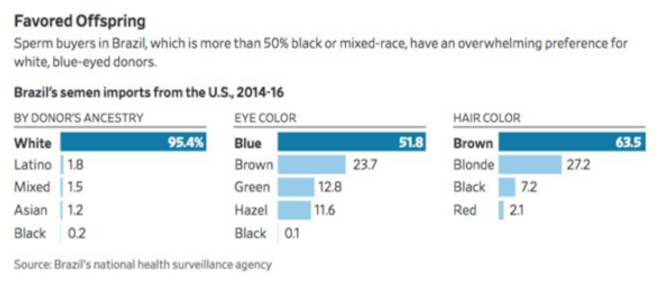
Departing from pie charts and bar charts, there are amazing chart types to explore. My personal favorite is the Sankey Diagram.
After Ebola outbreak in West Africa, donors pledged $4.5 billion toward recovery. Less than a third of that money has been disbursed. Graphic by @JoelEastwood https://t.co/xbucKqbVdV pic.twitter.com/IWMg7K5MNb — WSJ Graphics (@WSJGraphics) March 20, 2018
If you’re stumped about which chart/graph to use, you may find this guide helpful.Pie charts are popular but often not the optimal choice. Bar charts are workhorses for #dataviz. @clare_mcd Click To Tweet
To prove that smart people prefer simple data visualizations, check out the annual blogger survey from Orbit Media’s Andy Crestodina. He uses simple, horizontal bar charts to convey his findings every year.
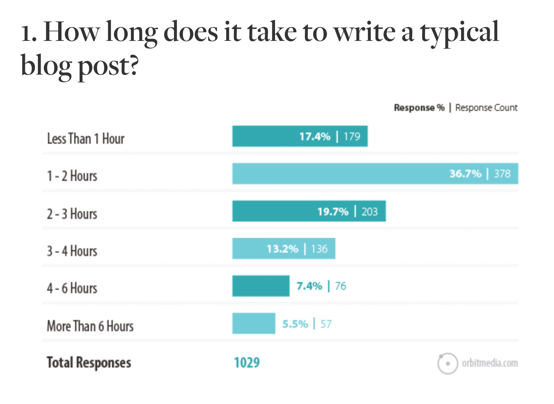
HANDPICKED RELATED CONTENT: 6 Mistakes Ruining Your Charts and Infographics
Consider interactive
Some of the most interesting visualizations are interactive, meaning the viewer can filter the data in new ways or uncover layers of data below each chart. The option is particularly nice when you have a sample size large enough to support comparisons of multiple dimensions. (For example, if you examine a finding by viewing responses by industry, you can only do that if you have enough people within each industry category to ensure that each data point presented is statistically significant.) Check out the gallery on Tableau Public to see how it works.
HANDPICKED RELATED CONTENT: Interactive Content: The Good, Bad, and Wicked Cool Quizzes and Games
Choose viz technology carefully
The wealth of tech tools to help you visualize is nothing short of freaking amazing. I’ve found, however, that tools designed primarily for layout or design rather than dataviz are usually an exercise in frustration. I have wasted more time fiddling with some of them than I care to admit. What you really want are tools designed specifically for visualizing data, not just visualizing stuff.Use tools designed for visualizing data, not just visualizing stuff, says @clare_mcd. #dataviz Click To Tweet
According to HBR’s Scott, your most critical tools before using any technology are pen and paper – and he’s correct. (His book spends a good deal of time talking about sketching out ideas and how to choose chart types, my favorite part of the book.)
With a sketch as your guide, for basic visualizations I recommend Plotly or Datawrapper. (Good ol’ Excel is another option though it frustrates me quickly.) Scott also recommends Quadrigram, though I have not used it. Another tool I’m eager to try: Google Data Studio.
For more advanced visualizations, Tableau is an amazingly powerful option suited to intermediate or advanced users.
Of course, tools need data to make the magic. You can access both free and paid datasets through a variety of communities and companies. Through some sites, you’ll find relatively clean data ready to visualize, while others require developer skills to query and clean. To understand what’s available, scan through communities like Kaggle, Google Public Data, and Github Data. And, if you have the budget, you can license an array of data. A great example is Attom Data Solutions, a repository for property data. (If you’re on the hunt for niche data, the r/datasets community on Reddit is a good place to ask questions.)
Read up before you dive
While you may be inclined to dive in and start experimenting, I recommend pairing your experiments with some reading. For beginners who don’t expect to go far beyond updating presentation decks, I highly recommend The Wall Street Journal’s Guide to Information Graphics. It’s a great primer on the do’s and don’ts of clear, simple viz design. (The book’s lessons about color choices are worth the price.)
For those with more than a passing interest, Scott’s Good Charts is an excellent guide, as is Storytelling with Data: A Data Visualization Guide for Business Professionals by Cole Nussbaumer Knaflic.
If you’re interested in visualizing public data sources, Niel Malhotra from Growista wrote an online guide to research and his chapter about accessing and analyzing existing data is informative. (Niel’s background is programming.)
Finally, one of the most inspiring things you can do is to see what others are doing. I often visit the communities on Tableau, Data is Beautiful (on Reddit), and Information is Beautiful. Another great source of information is following data journalism sites on Twitter, such as @GuardianData, @BBGVisualData, @ReutersGraphics, @GuardianVisuals, @NYTGraphics, and @WSJGraphics.
Last, but not least, have fun with dataviz.
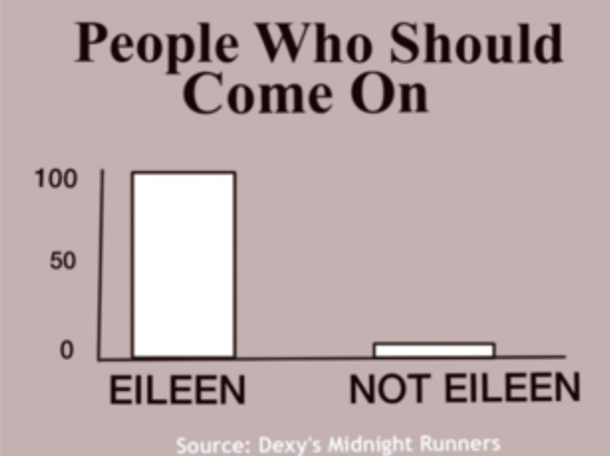
Please note: All tools included in our blog posts are suggested by authors. No one post can provide all relevant tools in the space. Feel free to include additional tools in the comments (from your company or ones that you have used).
Learn more from Clare McDermott and her research-related insight as she presents at Content Marketing World Sept. 4-7 in Cleveland, Ohio. Register today and use code BLOG100 to save $100.
Cover image by Joseph Kalinowski/Content Marketing Institute








Comments